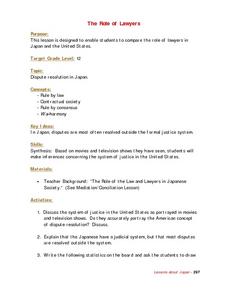Curated OER
The Role of Lawyers
Twelfth graders compare and contrast the role of lawyers in Japan and the United States. After viewing movies and television shows, they make guesses about the justice system in the United States. They answer discussion questions and...
Curated OER
Literature Soundtracks
Student choose ten songs to create a soundtrack for a novel read in class or as outside reading. In the liner notes, instead of lyrics Students writes a rationale of why or how the song relates to the novel in terms of setting,...
Curated OER
Culture Clash
Students watch the movie, Mr. Baseball, and discuss the difference between Japanese and American cultures.
Curated OER
Learning Abstract Concepts
Students create iMovies depicting abstract concepts, such as sorrow, future, wishes, infinity, etc., in this technology-based Visual Arts/Language Arts lesson. Music can be used to enhance created movies.
Curated OER
Animated Cartoons
Students draw ten frames for a cartoon and then use iMovie to create an animated movie in this technology-based art lesson. Transitions and audio tracks can be added to enhance final products.
Film Foundation
Film Language and Elements of Style
How do you read a frame? How do you read a shot? Here's a resource that shows viewers how to read films. As part of the study, class members examine the camera angles, lighting, movement, and cinematic point of view in Mr. Smith Goes to...
Curated OER
Simulated Air Trip to Seoul, Korea
Students become acquainted with the geography and culture of Korea. In this Korean trip lesson, students view a video about Korea and read about the country. Students sample snacks and possibly learn a Korean phrase as they...
Curated OER
States Of Matter
Delv into the states of Matter. Students engage in the scientific inquiry process to uncover the exciting world of Matter. They watch a series of videos, and conduct experiments in order to collect and analyze data on the various state...
Curated OER
ASL: Lesson 5
Sign language is an effective way to communicate with those special needs, hearing, impaired, and non-verbal pupils. This lesson provides a highly structured way to learn or teach ASL. Included are multiple links to images, descriptions,...
K!2 Reader.com
Interrogative Pronouns
To whom will you assign this exercise that focuses on interrogative pronouns? Your learners, of course! Learners complete 18 sentences by adding in the correct interrogative pronouns. The page includes a list of pronouns to choose...
It's About Time
Effect of Lenses on Light
Optometry jokes just get cornea and cornea. Young scientists use a lens and light to create and measure focal points on both a note card and the wall. They then complete a reading passage and questions as homework.
Curated OER
Past Time
Review important grammatical rules. Focusing on the past tense, learners practice concepts that are used to form sentences in the past tense. This could a good activity at a center.
Curated OER
Student Opinion: Are You Popular, Quirky or Conformist?
Approach the topic of popularity with this resource from the New York Times and their Learning Network series. The article is about Alexandra Robbins' "Quirk Theory." Learners respond to the article excerpt either on paper or...
Curated OER
Introduce: Prediction
What will happen next? Leave readers at a cliffhanger as they practice prediction strategies while listening to a story. Pupils start by making guesses based on the book's cover and title, discussing the techniques they use to make these...
Curated OER
Dancing in 3's
This dance makes me want to just get up and start moving right now. This dance is done to the song "Footloose" by Kenny Loggins. The activity includes not only step-by-dance step instructions but also a video. There is a lot of movement...
Perkins School for the Blind
Conversation Skills
It is so important for learners with multiple disabilities to learn how to communicate for both social and functional reasons. Each child will choose a topic from the list and generate five questions related to that topic. They'll split...
K12 Reader
Context Clues: The Meaning Is There!
Learning how to use context clues is helpful for both reading comprehension skills and to determine the meaning of unfamiliar vocabulary words. As they read ten sentences with underlined words, learners choose the most...
Center for Technology in Teaching and Learning
CSI: The Experience - Family Forensics
Forensic scientists depend on their observation skills to analyze evidence down to the molecular level. Middle and high schoolers practice making observations and predictions with a series of crime scene activities, which includes a...
Curated OER
Prewriting Strategies
Fourth graders explore various strategies to overcome fears of writing, and utilize a story map as a prewriting strategy. They read and discuss the steps of the writing process, follow the steps along with the teacher as they discuss the...
Curated OER
Harry Potter: Study Questions
Elementary learners explore fiction storytelling through partcipating in a survey. They identify the characters, themes and plot of the Harry Potter series while discussing their opinions in class. Learners conduct a survey about their...
Curated OER
Capitalization in Sentences
Woah, these sentences need some capitals! Learners examine 10 incorrect sentences to determine which letters should be capitalized. They circle names, restaurants, sentence-starters, titles, planets, days of the week, locations, and...
Curated OER
Grammar Practice: Parallel Structure
Help your young writers improve the clarity of their sentences by showing them how to create parallel structures as they construct sentences. Two exercises give kids practice identifying the correct parallel structure and crafting...
Curated OER
Grammar Bytes: Capitalization
While a comprehensive exploration of capitalization rules, this presentation is geared toward high school students and may contain elements teachers would want to change. The examples may contain subject matter that could be altered to...
Curated OER
Isn't It Ironic?
After examining the definitions of situational, dramatic, and verbal irony viewers are presented with a series of situations and asked to label the type of irony each example represents. The photos alone make this slide show worth a look.

























